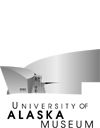The Arctic Alaska Dinosaur Project: A History of Collaboration
|
Timeline in brief:
1985: Exploratory excavations and stratigraphic studies
along the Colville River reveal significant dinosaur bone beds.
1987–1990: Thousands of specimens are collected, new
sites are discovered, and data added as the work on the Colville
River progresses under the leadership of UCMP.
1991 to the present: The Arctic Alaska Dinosaur Program
develops, and the center of research shifts to the UAM. Discoveries
include trackways and new bone beds. The collections grow to become
the largest and most diverse Late Cretaceous polar dinosaur collection
in both hemispheres.
2002: The two museums collaborate to provide a program of
geoscience education for K–12 teachers in the West Contra Costa
County Unified School District, adding a new dimension to the partnership.
|
|
—Roland A. Gangloff, Curator Earth Science Department University
of Alaska Museum
1985. During the summer of 1985, a team
of geologists and paleontologists from the University of Alaska,
Fairbanks, the University of California, Berkeley, and the United
States Geological Survey completed a set of exploratory excavations
and stratigraphic studies along the western and northwestern bank
of the Colville River near Ocean Point, in Alaska. This work clearly
established that a series of stratigraphically separate bone beds
contained significant numbers of dinosaurs known as hadrosaurs.This
work was the beginning of a collaborative research and curational
program involving the University of Alaska Museum (UAM) and the
University of California Museum of Paleontology (UCMP), which laid
the foundation of what continues today as the Arctic Alaska Dinosaur
Program (AAPD).
1987–1990. During this very productive
period, several microvertebrate sites were discovered. Over three
thousand teeth and bones were collected, mapped, and curated, and
the first specimen of a pachyrhinosaurid outside of Alberta, Canada
was located and collected. Scientists from the United States Geological
Survey and two independent researchers from Great Britain and the
University of Arizona added valuable information regarding ancient
environments and climatic patterns from invertebrate and plant fossils
associated with the dinosaurs and other vertebrates. Work during
this interval, including a detailed analysis of the fossilization
process (taphonomy), concentrated on the largest and most fossiliferous
accumulation of bones, known as the Liscomb bone bed. Work during
this period was led by UCMP and underwritten by two grants from
the Division of Polar Projects, National Science Foundation and
resources from UAM.
1991 to the present. Leadership of the
research program, now formally named the Arctic Alaska Dinosaur
Program, shifted from UCMP to UAM during this period. A primary
goal during the first five years was the continuation of detailed
taphonomic mapping along the entire length of the Liscomb bone bed.
Continued research included further evaluation of the original bone
beds and the discovery of the first dinosaur trackways, the first
pachyrhinosaur bone bed, and the first evidence of a pachycephalosaur.
Cooperation by both institutions over the last five years is resulting
in the complete transfer of all specimens from the North Slope of
Alaska to the Earth Science Collections of the UAM. Students and
senior researchers from both institutions continue to collaborate
on research and curation of what has become the largest and most
diverse Late Cretaceous polar dinosaur collection in both hemispheres.
This collection now contains over 8,000 skeletal elements.
2002. UAM and UCMP created a program
of geoscience education for K–12 teachers. Supported by the National
Science Foundation, the West Contra Costa Unified School District,
and Mechanics Bank, a group of K–12 teachers will spend a month
in Alaska learning about geologic processes and principles first-hand.
The teachers will learn geologic field skills and basic vertebrate
paleontological field techniques, followed by the fundamentals of
collection curation. Following the field trip, the team will work
together to develop and implement a K–12 Earth Science curriculum
for the district.
|








